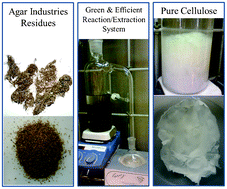Free-lignin cellulose obtained from agar industry residues using a continuous and minimal solvent reaction/extraction methodology
Abstract
Herein we present a green procedure to obtain cellulose (Cel)

* Corresponding authors
a Universidad Autónoma Metropolitana, Unidad Iztapalapa, San Rafael Atlixco 186 Col. Vicentina, México, D.F., México
b
Universidad Autónoma Metropolitana, Unidad Cuajimalpa, Departamento de Ciencias Naturales, Pedro Antonio de los Santos 84, Col. San Miguel Chapultepec, D.F, México
E-mail:
hbeltran@correo.cua.uam.mx
Tel: (55) 2636 3806
c
Universidad Autónoma Metropolitana Unidad Cuajimalpa, Departamento de Procesos y Tecnología, Pedro Antonio de los Santos 84, Col. San Miguel Chapultepec, D.F, México
E-mail:
mhernandez@correo.cua.uam.mx
Tel: (55) 2636 3818
Herein we present a green procedure to obtain cellulose (Cel)

 Please wait while we load your content...
Something went wrong. Try again?
Please wait while we load your content...
Something went wrong. Try again?
R. López-Simeon, J. Campos-Terán, H. I. Beltrán and M. Hernández-Guerrero, RSC Adv., 2012, 2, 12286 DOI: 10.1039/C2RA22185C
To request permission to reproduce material from this article, please go to the Copyright Clearance Center request page.
If you are an author contributing to an RSC publication, you do not need to request permission provided correct acknowledgement is given.
If you are the author of this article, you do not need to request permission to reproduce figures and diagrams provided correct acknowledgement is given. If you want to reproduce the whole article in a third-party publication (excluding your thesis/dissertation for which permission is not required) please go to the Copyright Clearance Center request page.
Read more about how to correctly acknowledge RSC content.
 Fetching data from CrossRef.
Fetching data from CrossRef.
This may take some time to load.
Loading related content
